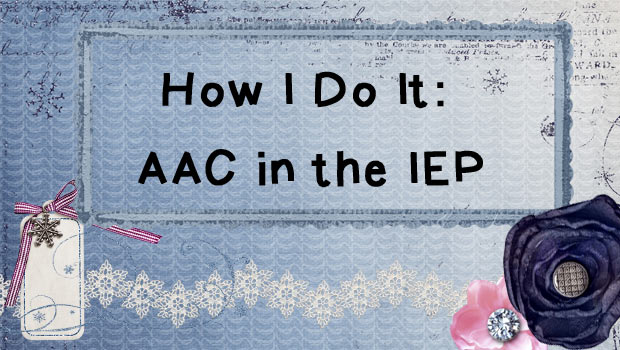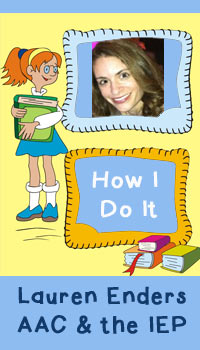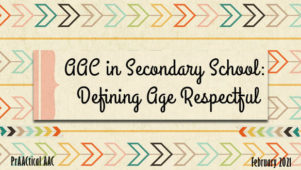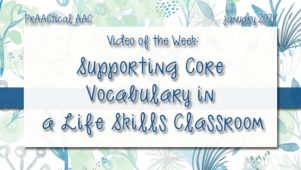How I Do It: AAC in the IEP

We’re happy to welcome back, Lauren Enders, an AAC specialist from Pennsylvania. You can read her earlier post here. This month, Lauren shares some of ways she addresses AAC learning in the IEP.
she addresses AAC learning in the IEP.
Frequently, SLPs and teachers contact me in a complete panic because they need to generate an IEP and write IEP goals for a student who is using (or beginning to use) Augmentative and Alternative Communication (AAC). These folks have lots of questions and most often, have no idea where to begin. There are a number of questions that come up repeatedly in these panicked requests. When approached by PrAACtical AAC to write a post about IEPs and AAC, I thought it might be helpful to share some of the most common questions I hear along with the answers I provide. I will structure the post in a Question & Answer format in the hopes that the post is an easy read and useful as a quick reference that you can pull out during the IEP writing process. In this post, Part One, I will focus on how and where to enter AAC into the IEP. In an upcoming post, Part Two, I will concentrate on suggestions for writing functional and measurable goals for your students who need AAC.
QUESTION 1: “Should we check the box that asks ‘Does the student need assistive technology devices and/or services’?”
ANSWER: YES!! As part of the Individuals with Disability Education Improvement Act (IDEA 2004), Augmentative and Alternative Communication (AAC) devices, supports, and services fall under the category of Assistive Technology Devices and Services.
Assistive Technology Device – IDEA 2004 Definition: any item, piece of equipment, or product system, whether acquired commercially off the shelf, modified, or customized, that is used to increase, maintain, or improve functional capabilities of a child with a disability http://tinyurl.com/atphg5y
Assistive Technology Service – Definition: any service that directly assists a child with a disability in the selection, acquisition, or use of an assistive technology device http://tinyurl.com/at4w36j
U.S. Department of Education (March 13, 2013). Building the Legacy: IDEA 2004 [website]. Retrieved from http://tinyurl.com/atphg5y
So, all AAC systems from paper-based (manual) communication boards, to single message devices like BigMacks, all the way through to the highest tech systems (including iPads with AAC apps and dedicated high-tech communication devices) are considered forms of Assistive Technology.
CRUCIAL: For assistive technology tools or solutions (including AAC) to be successfully implemented, most teams require one or more assistive technology services. (Click on the link above to learn what services are considered assistive technology services.) When I talk about the team, I mean everyone who is interacting with the child…the teachers, therapists, support staff, parents (of course) and sometimes even support staff from home. I am finding that most teams need repeated consultative visits with not only “training” but modeling of HOW to teach the student to communicate via AAC. I’d say that most teams need a minimum of four visits to train, provide resources, and model, model, model.
Talking about consultation services leads us to the next question.
QUESTION 2: “How should we list Augmentative & Alternative Communication (and other Assistive Technology consultation services) in the IEP?”
ANSWER: If AT & AAC consultation services are needed for the team, they are generally placed under Supports for School Personnel (this is where my services land on IEPs in my county). They should be written as Assistive Technology Consultation or Augmentative Communication Consultation. If the student will receive direct contact from the consultant, the time is most often listed under Related Services and should generally be written as Assistive Technology or Augmentative Communication Services. Different school systems will dictate where AT/AAC services must be listed in the IEP, so be sure to check with your LEA!
Note: When determining frequency of consultation visits and the amount of time spent during each visit, please be sure to check with your AT/AAC Consultant before finalizing the IEP!! I can’t tell you how many times I’ve found out after the fact that my services have been written into an IEP (sometimes for provision of services once a month)! Yikes!
QUESTION 3: How should assistive technology equipment/software (including augmentative communication systems) be written on the Supplementary Aids and Services Section of the IEP?
ANSWER: “Assistive technology equipment should be described in general, non-specific terms under the “Supplementary Aids/Services; Modifications; Accommodations” section when the student has access to the equipment on a long-term basis.”
DO NOT NAME SPECIFIC TOOLS OR DEVICES
The following are some examples of how to describe equipment (rather than naming it):
- single message voice output device (NOT Big Mack)
- portable device with touch screen capability (NOT iPad, iPod)
- dynamic display device with keyguard (NOT Dynavox V)
- communication system including communication book, topic boards, and choice boards (not Boardmaker symbols)
Portland Public Schools – Portland Oregon (March 13, 2013) Assistive Technology Team / Augmentative & Alternative Communication: Frequently Asked Questions [website]. Retrieved from http://tinyurl.com/as2k4lz
The reason we don’t name specific tools or devices is that there are times when the device is not available (due to breakage, battery drainage, being left at home, or simply not being an effective tool in a certain setting). If we name the device and don’t use it at certain times, we are out of compliance whenever the device is not in use!
Note: In this Supplementary Aids and Services Section of the IEP, you must also “Identify what IEP objective it (the AAC system) addresses (e.g. expressive communication/language).
Saint Paul Public Schools (March 13, 2013) Special Education –Assistive Technology in the IEP [website] Retrieved from http://tinyurl.com/a5s5ruu
QUESTION 4: If we are still trialing devices or communication boards through the SETT process, should those devices/supports be written into the IEP?
ANSWER: NO!! If you are still exploring, there is a chance that the trial device or support won’t be the right match for the student. If the trial AAC tool is written into the IEP but is not the one that is eventually implemented, the team will have to re-open the IEP to remove the trial device/support and add the final solution.
If there is room next to the box where you check off that the students needs assistive technology, I recommend that you write that the IEP team is in the process of exploring communication options for the student via the SETT process. If a comment box is not available, ask your LEA where in the IEP they would like to note that AT/AAC is being explored via the SETT process. Different school districts will have different procedures, so it’s essential that you check with your LEA!!
Be sure to explore the following excellent resource developed by the Georgia Program for Assistive Technology (GPAT) and shared by the Oregon Technology Assistance Program (OTAP) http://tinyurl.com/aqgk39j This resource includes additional information not touched upon in the above sections!
Lauren will be back next month with more information on IEP issues. In the meantime, you can follow her Pinterest boards and Facebook page, or connect with her on Twitter (@lasenders).
Filed under: PrAACtical Thinking
Tagged With: education, How I Do It, IEP, Lauren Enders, schools
This post was written by Carole Zangari





7 Comments
Question about naming device in IEP– what if you WANT the school to be out of compliance if they aren’t using the device? For example, if the device is sent out for repairs for a long time, and you want the school to make the effort to get a loaner, and not just wait for it to come back for 3 months. Or if my child uses a specific device, chosen after long trials and is the device that works for her, and we need to move to another district, and don’t want the district to say something else is just as appropriate?
Good question, Donna! If the IEP states that the student must have access to a voice output communication device with the features of that system VERY specifically listed/described (even if the specific device is not listed) and the district fails to repair the device/provide a loaner that matches that set of features, they are out of compliance. For the second question, was the device selected via the SETT process or another documented evaluation process with trial data? If so, that can be used as evidence of the need for that specific support.
Lauren
I fought hard to make sure my child’s AAC device was mentioned by name in the IEP, but I the parent had to own the device, and I also purchased a back up device for when the primary unit was out for repair (also had to bring an attorney). The IEP names the device as being “parent provided [model]” to clarify that the responsibility is on me. It’s sad to say, but some schools will fall back to paper PECS because they don’t want to deal with the devices. There will always be some excuse that the device isn’t working properly or the battery is dead, etc. I also recommend that you write into the IEP that the classroom have adequate chargers, outlets, extension cords, flashdrives, etc to support the device. I have heard every excuse for not using the devices.
Great Piece
Hi, Thanks for this information! The last link you listed to the pdf file has a “)” at the end of it, so I’m getting a 404 error from the tinyurl link. Hope you can fix it. This is the link in the meantime:
http://www.otap-oregon.org/Documents/Documenting%20Assistive%20Technology%20in%20the%20IEP.pdf
They changed the location again! Here’s the new link-
https://douglasesd.k12.or.us/sites/douglasesd.k12.or.us/files/File/at-resources/at-documents/at-in-iep/documenting-at-in-iep.pdf
Do you recommend naming specific symbols sets (Symbolstix, PCS, etc)?